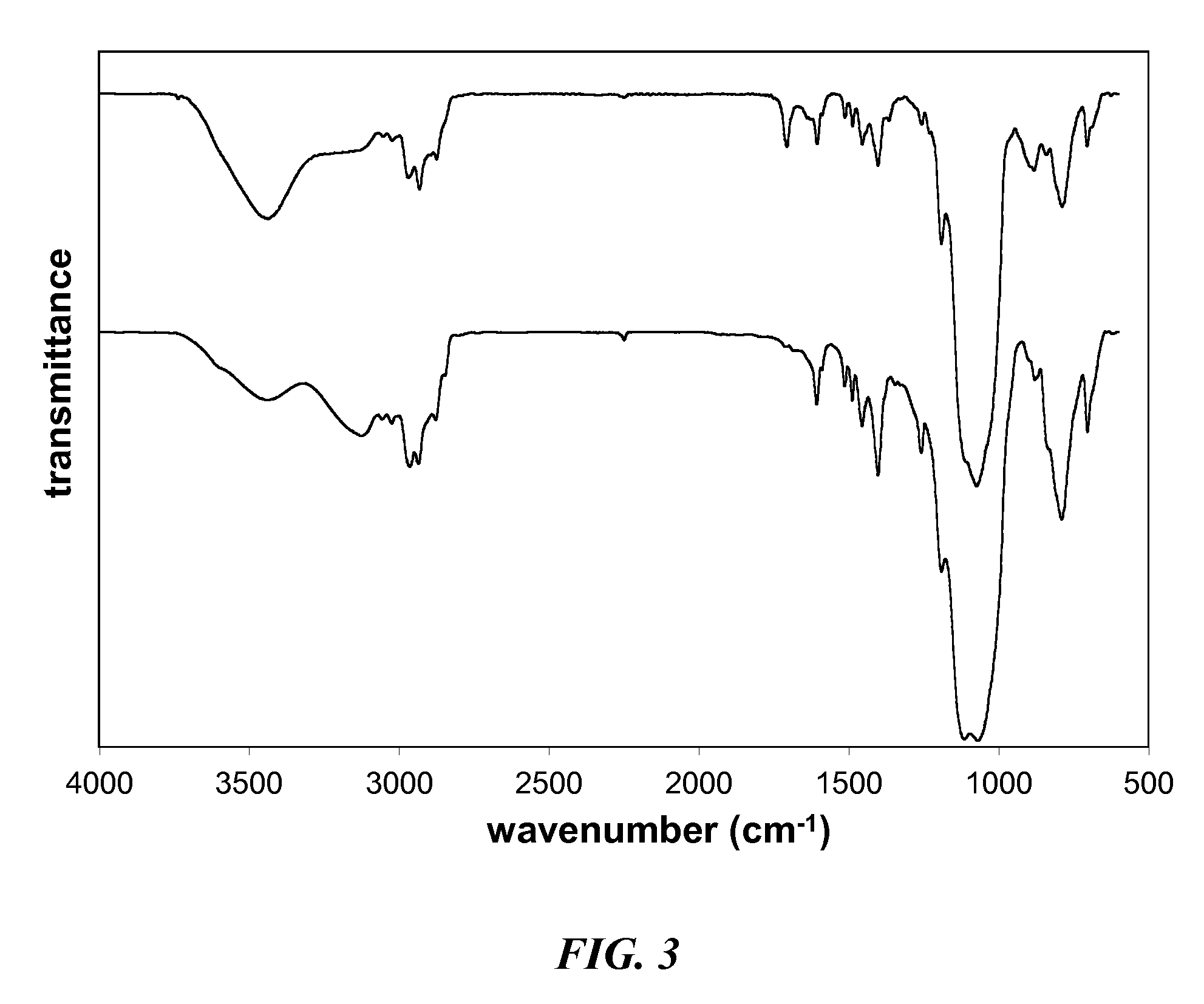Swellable sol-gels, methods of making, and use thereof
a sol-gel and composition technology, applied in the field of swellable sol-gel compositions, can solve the problem that amine-bridged sol-gels are only capable of very limited swelling
- Summary
- Abstract
- Description
- Claims
- Application Information
AI Technical Summary
Benefits of technology
Problems solved by technology
Method used
Image
Examples
example 1
Sol-Gel Preparation and Characterization
[0057] Sol-gels prepared by TBAF catalysis contained 27.6 mL of either tetrahydrofuran (THF) or ethanol, 6.24 mL of BTEB, 972 μL of H2O, and 180 μL of 1.0 M TBAF in THF. After gelation, the materials were aged for 6 days in a closed container at 25° C. and were sequentially extracted with ethanol twice and acetonitrile twice over a 4 day period. Prior to rinsing, the gels were crushed into ˜3-5 mm pieces to allow for more rapid exchange between the solvent and the gel. The sol-gels were then incubated in 20 mL of a 5% v / v solution of one of six chlorosilane reagents, as shown in FIGS. 1A-E, in acetonitrile for 48 h at room temperature. The gels were then rinsed three times with acetonitrile over 3 days and dried for 2 hr at 60° C. in a standard laboratory oven. The material was then ground in a bead mill to generate a powder.
[0058] The same general procedure was used to prepare acid catalyzed sol-gels except 375 μL of concentrated HCl was us...
example 2
Swelling Capacity of Sol-Gels
[0063] Swelling was measured by adding sorbate (e.g., organic solvents) drop-wise to 100 mg of dried sol-gel until the first appearance of non-absorbed solvent was noted. The amount of sorbate was determined by the difference in weight. When swelling was tested in two-phase mixtures, sol-gel was added stepwise to the sorbate system.
[0064] All of the TBAF catalyzed sol-gels prepared in THF and modified with one of the chlorosilane reagents described herein above exhibited the ability to swell approximately five to seven times their initial volume when placed in an organic solvent (see Table 2, below) which returned them to their pre-dried volume. Swelling occurred nearly instantaneously when liquid was added. There is no relationship between the polarity of the organic solvent and the degree of swelling. However, none of the sol-gels swelled in water due to the fact they are hydrophobic. Also, sol-gels placed in 80:20 v / v water:methanol did not swell, a...
example 3
Analysis of Sorbate Adsorption by Sol-Gels
[0069] Dried sol-gels (30 mg) were added to 1.00 mL solutions of methanol containing 50 ppm each of a mixture of 11 hydrocarbons (Supelco 8270 Matrix Spike Mixture) to determine if the sol-gels preferentially adsorb specific types of molecules. The sol-gels swelled and were incubated in the mixture for 48 h. The amount adsorbed was determined by measuring the amount of each molecule remaining in solution by liquid chromatography using an Agilent 1100 HPLC (4.6×150 mm Zorbax-C8 column; flow rate 1.0 mL / min; mobile phase: acetonitrile:water 20:80 ramped to 100:0 over 24 min; diode array detection) (Agilent Technologies, Palo Alto, Calif.).
[0070] Each of the TBAF / THF sol-gels prepared with various chlorosilanes were tested to determine if the surface properties were dictated by the choice of reagent used to derivatize the sol-gel during processing. This was accomplished by measuring the extent of the sorbate adsorption from an organic solvent...
PUM
| Property | Measurement | Unit |
|---|---|---|
| temperature | aaaaa | aaaaa |
| temperature | aaaaa | aaaaa |
| particle size | aaaaa | aaaaa |
Abstract
Description
Claims
Application Information
 Login to View More
Login to View More - R&D
- Intellectual Property
- Life Sciences
- Materials
- Tech Scout
- Unparalleled Data Quality
- Higher Quality Content
- 60% Fewer Hallucinations
Browse by: Latest US Patents, China's latest patents, Technical Efficacy Thesaurus, Application Domain, Technology Topic, Popular Technical Reports.
© 2025 PatSnap. All rights reserved.Legal|Privacy policy|Modern Slavery Act Transparency Statement|Sitemap|About US| Contact US: help@patsnap.com



